Intangir Bot (talk | contribs) m (relinking to Scion (Ivalice); cosmetic changes) |
HarpieSiren (talk | contribs) No edit summary |
||
| Line 3: | Line 3: | ||
'''Limit Breaks''', also known simply as '''Limits''' {{J|リミット|Rimitto}}, are powerful combat moves featured in several [[Final Fantasy (Series)|''Final Fantasy'']] titles. The mechanism originates from ''[[Final Fantasy VI]]'', but the term was not officially coined until ''[[Final Fantasy VII]]'', which popularized the term; later games often use other names. Limit Breaks are among the most damaging moves at a player's disposal, and several Limit Breaks have developed into various characters' signature moves. |
'''Limit Breaks''', also known simply as '''Limits''' {{J|リミット|Rimitto}}, are powerful combat moves featured in several [[Final Fantasy (Series)|''Final Fantasy'']] titles. The mechanism originates from ''[[Final Fantasy VI]]'', but the term was not officially coined until ''[[Final Fantasy VII]]'', which popularized the term; later games often use other names. Limit Breaks are among the most damaging moves at a player's disposal, and several Limit Breaks have developed into various characters' signature moves. |
||
| − | Limit Breaks usually rely on the damage the player takes in some way. When the player takes enough damage to fill up a power meter, or they enter [[HP Critical]] status, they may perform a Limit Break. However, this is not universal and some games use different systems. Though their appearance, use and naming has varied, Limit Breaks |
+ | Limit Breaks usually rely on the damage the player takes in some way. When the player takes enough damage to fill up a power meter, or they enter [[HP Critical]] status, they may perform a Limit Break. However, this is not universal and some games use different systems. Though their appearance, use and naming has varied, the concept of Limit Breaks has become a series staple. |
==Appearances== |
==Appearances== |
||
| Line 418: | Line 418: | ||
{{Limit Breaks}} |
{{Limit Breaks}} |
||
{{Miscellaneous}} |
{{Miscellaneous}} |
||
| − | |||
[[Category:Limit Breaks| ]] |
[[Category:Limit Breaks| ]] |
||
[[Category:Battle Elements]] |
[[Category:Battle Elements]] |
||
Revision as of 21:04, 4 November 2014
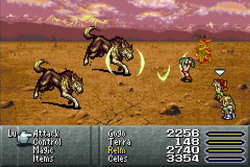
Terra using Riot Blade in Final Fantasy VI as her Desperation Attack, the first appearance of a Limit Break.
Limit Breaks, also known simply as Limits (リミット, Rimitto?), are powerful combat moves featured in several Final Fantasy titles. The mechanism originates from Final Fantasy VI, but the term was not officially coined until Final Fantasy VII, which popularized the term; later games often use other names. Limit Breaks are among the most damaging moves at a player's disposal, and several Limit Breaks have developed into various characters' signature moves.
Limit Breaks usually rely on the damage the player takes in some way. When the player takes enough damage to fill up a power meter, or they enter HP Critical status, they may perform a Limit Break. However, this is not universal and some games use different systems. Though their appearance, use and naming has varied, the concept of Limit Breaks has become a series staple.
Appearances
Final Fantasy VI
Template:Sideicon
Though the term Limit Break comes from Final Fantasy VII, the idea was first used in Final Fantasy VI. Desperation Attacks activate occasionally when a character is in critical health and the Attack command is issued. Desperation Attacks are one-time high-powered attacks that ignore defense and sometimes cause Instant Death to an enemy. They only hit one target and cannot be used twice in a battle.
All player characters, except Gau and Umaro, have a Desperation Attack. Gogo's Desperation Attack cannot be used if s/he is not equipped with the Attack command, nor can s/he Mimic others'. Desperation attacks are seen so rarely many players are unaware of their existence.
Final Fantasy VII
Template:Sideicon
Final Fantasy VII was the first game to use the term "Limit Break", and to make it a more central gameplay feature than the rarely seen Desperation Attacks of Final Fantasy VI. Despite the consistent use of "Limit Break" and "Limit" seen throughout Final Fantasy VII related Japanese media, the English version of the demo release used "Special Ability" and "Special".
According to the Final Fantasy VII tutorials, the Limit gauge fills as the character angers, hence the Fury and Sadness statuses, and when enemies push a character to their limits they unleash an "unimaginable power". According to the Crisis Core Complete Guide Keyword Collection', when spirit energy rises to its ultimate limit for a short while it aligns with and emits from the body, allowing powerful abilities that cannot be performed in a natural state.

Cloud preparing to use his Limit Break, Braver, on the Guard Scorpion boss.
Each character has a Limit meter that fills up as the character takes damage. When the bar is full, the character can unleash a special attack. Most characters have seven Limit Breaks spread over four levels of strength. Characters start with one Limit Break and learn the next five by killing enemies or performing lesser Limit Breaks, but their seventh and ultimate Limit Break can only be learned via a manual hidden somewhere in the game after acquiring the other six.
The exact effect of Limit Breaks vary. Most do damage, but others cast supportive and healing spells on the party. Each character's set of Limit Breaks has a specific "gimmick"; Cid uses Jump attacks, while Aeris heals and defends the party. For most characters, the player simply selects the attack from a command list once the Limit bar is filled, but Tifa and Cait Sith need the player to perform slots input sequence to determine the outcome for the Limit Break. Characters are unable use the Attack command once their Limit gauge is filled up, as the Limit command replaces the Attack command.
Before Crisis -Final Fantasy VII-
Template:Sideicon The Limit command is a story element. During the final battle, the player Turk will awaken to the power inside them and break their limits when Zirconiade runs out of HP. Only by selecting the Limit command may the final battle be ended.
Crisis Core -Final Fantasy VII-
Template:Sideicon
The Limit Break system is called the Digital Mind Wave (DMW), a set of three reels at the top left hand corner of the player's screen. The reels feature numbers and images of characters met in the game, and are constantly spinning throughout battle, provided the player has enough Soldier Points. Certain DMW number combinations buff the player while having the same image in the two end reels opens up the Modulating Phase in a separate screen of reels, which allows the player to perform Limit Breaks, summons, and level up. The DMW can become enhanced when specific events in the storyline boost Zack's emotions. New abilities are learned by progressing in the story and Zack can boost the chances of certain Limit Breaks by equipping the corresponding Materia.
Final Fantasy VII: Advent Children
Template:Sideicon
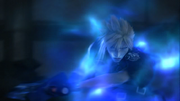
Cloud uses a Limit Break in Final Fantasy VII: Advent Children Complete.
Limit Breaks are used by several characters, mostly by Cloud whose Limit Breaks in are signified by a fiery blue aura appearing over him or his weapon. Though they do not feature the same aura, Tifa, Aerith, Barret, and Sephiroth also use moves similar to their Limit Breaks.
Dirge of Cerberus -Final Fantasy VII-
Template:Sideicon
Vincent Valentine can use two of his Limit Breaks from Final Fantasy VII: only the Galian Beast form can be used in normal gameplay, and Vincent transforms into this stronger, faster, and more powerful form using an item called the Limit Breaker. His Chaos form is used only in the last chapter through plot demands.
Final Fantasy VIII
Template:Sideicon
There is no limit bar and the mechanism that determines when a character can perform a Limit Break is an invisible piece of coding, but usually triggers when a character is in critical health. Other factors that influence the likelihood of Limit Break appearing are KO'd party members and statuses.
Limit Breaks always hit and ignore what the character has junctioned to elemental attack.
How to calculate a character's Limit Level:[1]
- HPMod = 2500 * CurrentHP / MaxHP
- DeathBonus = DeadCharacters * 200 + 1600
- StatusBonus = StatusSum * 10
- RandomMod = [0..255] + 160
- LimitLevel = (StatusBonus + DeathBonus - HPMod) / RandomMod
If (LimitLevel > 4) Limit Break can be used.
Seifer is a temporary character and uses a different HPMod:
- HPMod = 1000 * CurrentHP / MaxHP
Each status effect has a certain value. The StatusSum variable is the sum of all statuses in effect.
- 200 Aura
- 15 Slow
- 30 Poison/Blind/Silence/Gradual Petrify
- 45 Doom
By the casting of Aura, the character can easily reach the limit without being in critical health.
The so-called Limit Level works in adjacent to the Crisis Level that affects the move's potential strength.
Limit Level to Crisis Level conversion:
| Limit Level | Crisis Level |
|---|---|
| 4 or lower | 0 |
| 5 | 1 |
| 6 | 2 |
| 7 | 3 |
| 8 or higher | 4 |
A higher Crisis Level means the character's Limit Break is in some way enhanced. A character need at least Crisis Level 1 to be able to use a Limit Break. It is easy to reach the highest Crisis Level with the Aura spell, as a character only needs to be at maximum 11.2% of their maximum HP and be under Aura status to reach Crisis Level 4 100% of the time. Without Aura, a character with 10% HP has a 3% chance to get Crisis Level 4.
- For the Crisis Level effects on each character's Limit Break see the Crisis Level article.
When a character can use a Limit Break, an event that might seem random to players, a glowing icon appears next to the character's Attack command allowing them the choice to perform a "Limit Break" (known as Special Arts in the Japanese version). Unlike the previous two games, Limit Breaks in Final Fantasy VIII can be used as often as the player wishes as long as the option appears and skipping a character's turn will reset the probability of the Limit Break option.
Each character's Limit Break is exclusive and each has unique ways of obtaining and performing the Breaks: Squall has Renzokuken, which requires the player to time button presses with a flashing power meter; Quistis has Blue Magic where the player selects spells from a list; Zell has Duel where the player inputs button commands within a time limit; Irvine has Shot which expends ammo from the player's inventory; Rinoa has two Limit Breaks, Combine, which calls Rinoa's pet dog to attack the enemies and enhance the party, and Angel Wing, which puts her in a magic berserk state continually casting powerful spells; and Selphie has Slots which shuffles random magic spells. Temporary playable characters also have Limit Breaks, although less versatile.
Final Fantasy VIII is the first time an antagonist uses the Limit Break system; Seifer can use the Limit Break No Mercy when the player is in control of him and he can use his subsequent Limit Breaks in the battles against him. Other characters, such as Raijin, Fujin and GIM52A, have moves that function similar to Limit Breaks and will usually only use them if they have low HP or are under the Aura status. Edea also uses a Limit Break against Squall in an FMV called Ice Strike.
Final Fantasy IX
Template:Sideicon
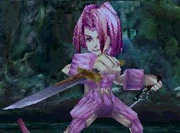
Zidane in Trance mode.
The Trance system brings back a bar to show the amount of Trance slowly building up over time, but rather than executing a special attack when the bar fills the character enters Trance state that lasts a short period of time, usually only a few turns. Tranced characters' stats are boosted and they can access special skills or their normal abilities are enhanced. For example, Zidane can use special Dyne attacks, while Steiner has his attack power tripled.
Certain story battles involve compulsory Trances, and at one point Dagger is unable to enter Trance due to her emotional state. Trance plays a role in the storyline even outside of battles with the characters Mog and Kuja.
Final Fantasy X
Template:Sideicon
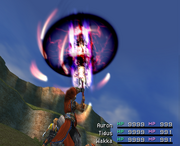
Auron's Overdrive "Banishing Blade".
The Limit Breaks are called Overdrives. Each character has an Overdrive meter that fills up over time, but the exact method of filling the bar is determined by the character's Overdrive Mode — they can fill the bar by healing allies, attacking enemies, using items, or under certain unfavorable conditions like in Final Fantasy VIII. Different characters learn new Overdrives via different methods. For example, Tidus learns new Overdrives by repeatedly using his old ones while Wakka must win them in the blitzball, and Auron learns them by searching for Jecht's Spheres.
For most characters, the Overdrive's strength is determined by some form of player input; Tidus's Swordplay requires the player to stop the moving cursor in the middle of a bar, Auron's Bushido grows stronger as the player inputs button commands, Wakka uses various slot type Overdrives where the player must stop the rotating reels on the desired attack, and so forth.
Aeons also have Overdrives, the first time in the series that summons can execute Limit Breaks. Their Limit Breaks are simpler, and function as strong attacks based on their usual summon ability. For example, Ifrit uses Hellfire, while Shiva uses Diamond Dust. Some bosses can also use Overdrives, their Overdrive gauge being visible to player, giving hint of when to brace for it.
Final Fantasy X-2
Template:Sideicon
Each character can access a special dressphere once they have activated all of the nodes on their Garment Grid during a battle, and upon activation only that character will be playable supported by support units belonging to the dressphere. The character can remain in their special dressphere until the end of the battle or until they decide to spherechange.
Spherechanging into a special dressphere raises the character's attributes and they receive a unique set of abilities unique to their dressphere. The special dresspheres are: Yuna's Floral Fallal, Rikku's Machina Maw, and Paine's Full Throttle. Each special dressphere possesses a unique ability that causes massive damage to all enemies but carries the cost of an entire ATB bar.
Final Fantasy XI
Template:Sideicon
Template:See Also As an online game with thousands of player heroes, Final Fantasy XI adapts the Limit Break concept into attacks called Weapon Skills which are associated with specific weapon types rather than individual characters. Most Weapon Skills are unlocked as adventurers gain proficiency with the appropriate arms. Similar to earlier games, characters have a gauge that fills with Tactical Points as they attack enemies or are attacked themselves.
Once the meter is full a Weapon Skill may be executed to deal significant damage to opponents or, in some cases, confer benefits to the party. Unlike previous Limit Break implementations players may delay using a Weapon Skill to accumulate more than a full bar of Tactical Points (up to 300) to add extra value to their eventual attacks.
The ongoing development of Final Fantasy XI has introduced a variety of features that supplement or complicate the basic Weapon Skills system. These include the Samurai job, which boasts improved control over the accumulation and expenditure of Tactical Points; Weapon Skills that must be earned from quests; the Dancer job, which adopts Tactical Points as a resource for its dances; and effects such as Regain which can award Tactical Points outside of combat.
While Weapon Skills are not as devastatingly powerful as other variations of the Limit Break, Final Fantasy XI provides adventurers with job-specific abilities that capture the spirit of the rare, life-saving talents wielded by the protagonists of previous games. The term "Limit Break" is also used to describe the quests that remove level caps for players level 50 and above.
Final Fantasy XII
Template:Sideicon
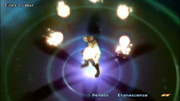
Balthier unleashing his Level 1 Quickening, "Fires of War".
Quickenings (Mist Knacks in the Japanese version) are purchased via License Points on the License Board, up to three for each character. Every new Quickening gives the character a new Mist Charge, increasing their MP. Quickenings are powerful cinematic attacks, and allow the player to shuffle and execute several characters' Quickenings in succession. This is called a Quickening chain, and if the right Quickenings are used a finishing blow called a Concurrence is executed. In the original version of the game, Quickenings are the main way for players to break the damage limit and with long enough Quickening chains, even low level parties can defeat powerful bosses and marks.
Espers have a 'deathblow' cinematic attack only used under certain circumstances, such as their summoner's HP being low or the Esper's remaining summon time going below a certain point. The attacks do heavy damage to all enemies in range.
There is also an enemy ability called Limit Break that reduces the charge time for magick and physical attacks to 0.
In the International Zodiac Job System version the Quickenings no longer use MP, but have their own bar, much like in previous installments.
Final Fantasy XII: Revenant Wings
Template:Sideicon

Vaan's Quickening, Pyroclasm.
The Quickenings work differently by, instead of expending MP, they are charged via a more traditional method by filling a Mist Charge bar, which is charged by different methods depending on the character in question; Vaan's Quickening bar fills as he and his group kill enemies, whereas Basch's Quickening charges when enemies attack him. Each permanent character has their own Quickening learned by defeating one of the thirteen s in battle. Each Scion teaches one character their Quickening. Each character's Quickening serves different purposes; some perform strong attacks and some heal and enhance the party. Quickenings are cinematic attacks that hit all enemies or allies, depending on the Quickening's nature.
Final Fantasy XIII
Template:Sideicon
Hope's Full ATB Skill "Last Resort".
There are two attack types for each playable character which could classify as similar to Limit Breaks: full ATB skills and an Eidolon's Gestalt Mode. With full ATB moves each character has a unique attack, which requires the whole ATB bar to use. These attacks deal extreme damage that ignore defense, or multiple strikes that rapidly increase the enemy's chain gauge. When using Eidolons the player can initiate Gestalt Mode where the Eidolon uses multiple techniques and powerful finishers to deal extreme damage to multiple foes.
Final Fantasy XIII-2
Template:Sideicon
Lightning's Feral Link "Legion of One"
Similarly to the first installment, there are two types of attacks which could classify as similar to Limit Breaks: full ATB skills and Feral Links. Serah and Noel each have a unique attack which requires the whole ATB bar to use. Unlike the previous game, they can only be used once per battle. However, if the player uses an Elixir, characters will be able to perform full ATB skills one more time. Each obtainable Paradigm Pack monster has a unique requiring to fill the Feral Link gauge before being usable. Many same Feral Links are assigned to several monsters of the same subtype.
Final Fantasy XIV: A Realm Reborn
Template:Sideicon
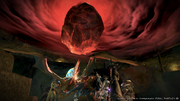
A Black Mage using the Meteor limit break.
Final Fantasy XIV: A Realm Reborn implements a Limit Break system for parties, in place of the Battle Regimens. Parties have a limit gauge that increases over time, and once it hits certain thresholds, a Limit Break may be used by one of the party members, which will empty the gauge. Depending on how much the gauge is filled the party may gain access to more powerful attacks.
The gauge can be increased faster by performing actions determined as "fine play", such as blocking enemy attacks. Limit Breaks have different effects depending on the role of the class or job of the player who uses them.
Final Fantasy Type-0
Template:Sideicon
Type-0 utilizes the Trinity Attack system where each character has his/her own Trinity Attack, but they require party of three members to be executed.
Final Fantasy Tactics
Template:Sideicon
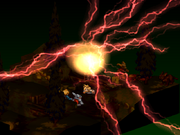
Cloud Strife Limit, Cherry Blossom.
"Limit" is the Job Command of the Soldier class exclusive to Cloud Strife. It possesses Cloud's Limit moves from Final Fantasy VII plus an extra skill, the Cherry Blossom. Cloud is only able to perform the Limit skills when equipping the Materia Blade and it can be retrieved from the highest grid at Mount Bervenia by Chemist's movement ability, Treasure Hunter.
The game has no Limit gauge so all Limit skills are magickal moves with certain Charge Time to execute. The power of the Limit moves are dependent on Cloud's magickal power, but since their Charging Speed is low by the time Cloud joins the player's party most of the moves are rather useless, except for Finishing Touch, which is quick to perform and inflicts instant KO, Stop or Petrify to targets within 2-grid effect radius.
Dissidia Final Fantasy
Template:Sideicon
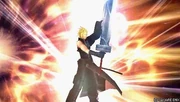
Cloud using Omnislash.
EX Mode is the Limit Break system of Dissidia and Dissidia 012. All characters have an EX Gauge displayed next to their HP bar that fills by collecting EX Force and EX Cores. Once full the character may enter EX Mode, enacting a transformation or granting them a stronger weapon. Characters in EX Mode gain Regen status, have an increased likelihood to inflict critical hits, and change their appearance. Fighters gain bonuses specific to them, including special attacks or enhanced normal attacks; for example, Terra can doublecast her spells, Sephiroth can use Heartless Angel, Cloud's attacks have Melee High priority, and so forth.
If the player lands an HP attack while in EX Mode they can execute an EX Burst, which lets them attack the foe with a series of powerful, unblockable Brave-draining strikes, leading up to a final HP attack. For the heroes, many EX Bursts are based on the character's Limit Break from their original game. In the case of the villains, their EX Bursts are based on their strongest attack as an enemy. Using an EX Burst ends EX Mode.
Dissidia 012 Final Fantasy
Template:Sideicon EX Mode returns in the prequel to Dissidia Final Fantasy. The mechanic is rebalanced as an opposite to the Assist mechanic, EX Mode and EX Bursts intended to act as final game-ending attacks while Assists act as weaker but more reliable support attacks. Numerous characters have had their EX Mode special effects changed, and due to the critical hit multiplier being reduced from 5x normal damage to 2x, EX Bursts usually deal less damage than in the first Dissidia.
Theatrhythm Final Fantasy
Template:Sideicon Each of the original thirteen characters has an exclusive ability learned at Level 40 named for their trademark Limit Break—Terra Branford learns Trance, Tidus learns Blitz Ace, and so forth. The heroes of the first five Final Fantasy games take their Limit Break names from their Dissidia EX Modes or EX Bursts. These abilities are exclusive to the Nintendo 3DS version and are removed in the iOS port.
With the exception of Lightning, whose Limit Break ability innately boosts her stats, the Limit Break abilities activate during Battle Music Sequence when certain conditions are fulfilled. Warrior of Light, Firion and Terra activate their Limit Breaks have chaining enough notes and they have effects that buff the party for the rest of the stage. The other nine characters have their Limit Break activate when a boss enemy enters the stage, and deal damage to it dependent of the user's stats, the stats used to calculate damage done varying for each character.
Bravely Default
Template:Sideicon
Special moves are triggered under certain conditions. They can be obtained by upgrading the shops in Norende.
| Weapon Type | Level | Special Move (Default Name) | Description | Buff for All Allies | Condition |
|---|---|---|---|---|---|
| Sword | 1 | Hack and Slash | Lower one enemy's Physical Defense by 25%, then attack five times with 60% the power of a normal attack. | Hit Count raised by 20%. | Brave 10 times. |
| 2 | Air Splitter | Deal 200% the damage of a normal attack to all enemies. | Physical Attack raised by 35%. | Brave 20 times. | |
| 3 | Sonic Wave | Attack one enemy with wind for 600% the damage of a normal attack. | Physical Attack raised by 50%. | Brave 30 times. | |
| Axe | 1 | Grand Strike | Attack all enemies for 150% the damage of a normal attack. | Physical Defense raised by 20%. | Defeat 5 enemies with physical attacks. |
| 2 | Maelstrom | Attack one enemy five times with 80% the power of a normal attack. | Hit Count raised by 35%. | Defeat 10 enemies with physical attacks. | |
| 3 | Gigaton Swing | Attack one enemy with earth for 600% the damage of a normal attack. | Physical Defense raised by 50%. | Defeat 15 enemies with physical attacks. | |
| Spear | 1 | Horizon | Attack one enemy for 300% the damage of a normal attack. | Critical Rate raised by 300%. | Inflict physical damage on 10 enemies. |
| 2 | Overpower | Attack one enemy six times with 60% the power of a normal attack. | Physical Attack raised by 35%. | Inflict physical damage on 20 enemies. | |
| 3 | Megiddo Flame | Attack all enemies with fire for 500% the damage of a normal attack. | Physical Attack raised by 50%. | Inflict physical damage on 30 enemies. | |
| Rod | 1 | Piercing Bolt | Attack one enemy for 150% the damage of a normal attack, ignoring the target's Physical Defense. | Magic Attack raised by 20%. | Use magic 10 times. |
| 2 | Withering Ripple | Lower all enemies' Physical and Magic Attack and Defense by 15% for four turns. | Magic Attack raised by 35%. | Use magic 20 times. | |
| 3 | Holy Weapon | Attack all enemies for 500% the damage of a normal attack, dealing additional damage to demonkind foes. | Magic Attack raised by 50%. | Use magic 30 times. | |
| Staff | 1 | Rejuvenation | Heal all allies by a massive amount. | Healing magic amplified by 100%. | Heal 10 times. |
| 2 | Lux | Raise Physical and Magic Attack and Defense of all allies by 25% for four turns. | Speed raised by 35%. | Heal 20 times. | |
| 3 | Divine Light | Attack one enemy for 700% the damage of a normal attack, dealing additional damage to undead foes. | Magic Attack raised by 50%. | Heal 30 times. | |
| Dagger | 1 | Infinity | Attack one enemy five times with 70% the power of a normal attack. | Hit Count raised by 20%. | Use items 5 times. |
| 2 | Blade Storm | Attack one enemy 15 times with 30% the power of a normal attack. | Hit Count raised by 35%. | Use items 10 times. | |
| 3 | Cross Divide | Attack one enemy 10 times with 70% the power of a normal attack. | Hit Count raised by 50%. | Use items 15 times. | |
| Bow | 1 | Maximum Draw | Attack one enemy for 300% the damage of a normal attack. | Critical Rate raised by 300%. | Exploit element/family weakness 5 times with physical attacks. |
| 2 | Rapid Fire | Attack one enemy with fire five times with 80% the power of a normal attack. | Hit Count raised by 35%. | Exploit element/family weakness 10 times with physical attacks. | |
| 3 | Angelic Pillar | Attack all enemies with light for 300% the damage of a normal attack. | Magic Defense raised by 50%. | Exploit element/family weakness 15 times with physical attacks. | |
| Katana | 1 | Moonshadow | Attack one enemy for 200% the damage of a normal attack with a high chance of stunning the target for several turns. | Physical Attack raised by 20%. | Default 5 times. |
| 2 | Breaking Wave | Attack all enemies with water for 200% the damage of a normal attack. | Critical Rate raised by 900%. | Default 10 times. | |
| 3 | Petal Swirl | Attack one enemy five times with 120% the power of a normal attack. | Speed raised by 50%. | Default 15 times. | |
| Knuckles / Unarmed | 1 | Moonbeam | Attack one enemy for 300% the damage of a normal attack. | Physical Attack raised by 20%. | Inflict critical damage 3 times. |
| 2 | Ascendant Palm | Attack one enemy 16 times with 30% the power of a normal attack. | Hit Count raised by 35%. | Inflict critical damage 6 times. | |
| 3 | Thunderburst | Attack one enemy with lightning for 500% the damage of a normal attack. | Physical Attack raised by 50%. | Inflict critical damage 9 times. |
Non-Final Fantasy Appearances
Kingdom Hearts series
In Kingdom Hearts II, all party members have a "Limit" command, while Donald and Goofy have two. The command costs Sora all his MP and initiates a special attack where he and the party member team up to attack all enemies the player having to press the button to attack as many times as possible within a time limit before the attack ends with a final blast that damages all enemies heavily. In Kingdom Hearts II: Final Mix+, Sora's Limit Form has the Limit command, which allows him to use Sonic Blade, Strike Raid, Ars Arcanum and Ragnarok, special attacks in the first Kingdom Hearts that were originally absent in Kingdom Hearts II.
In Kingdom Hearts 358/2 Days, every character has a Limit Break once their HP reaches a certain percentage, indicated by when the HP bar changes from Green to Yellow. After using the Limit Break, they use the ability for the duration of the time it takes for a white bar to reach the end of the HP bar starting from where life was at the time of activation. Every character has a unique limit break in multiplayer mode, and they all have a final limit that can be activated as a rebound with certain panels. Furthermore, there is a one use item that can be synthesized to restore the Limit Break Bar by one level, as well as a panel that allows the Limit Break to be first used at a higher percentage. While using a Limit Break, the character in question can still normally take damage.
Trivia
- In Fallout 2, companion Template:Wikia may remark during combat "wish I had a limit break".
References
Template:Limit Breaks Template:Miscellaneous

